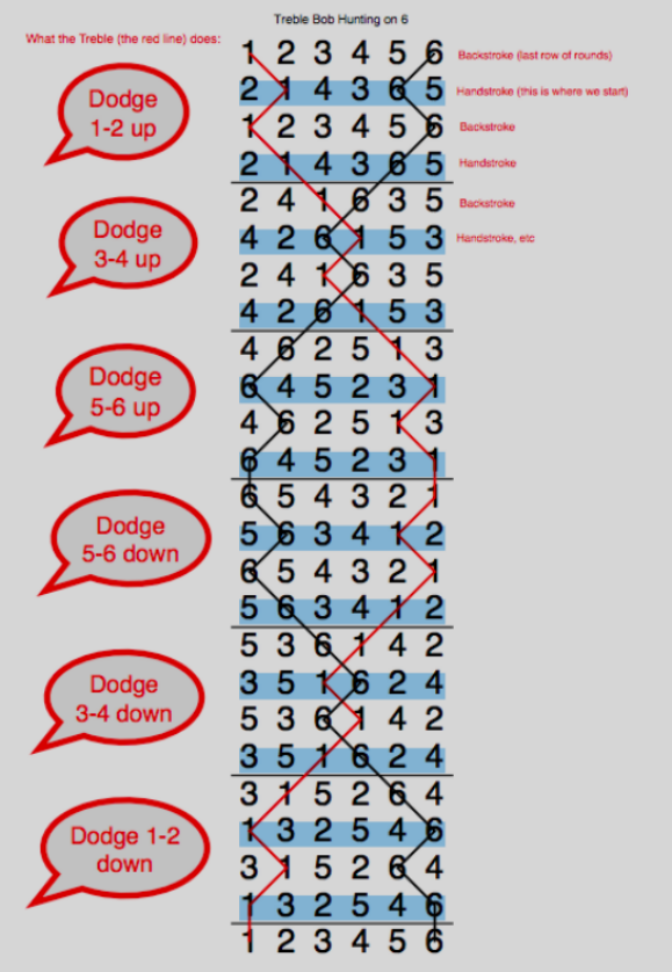26: Treble-Bobbing
This is what Treble Bob Hunting on 6 looks like:

If you compare the rows with Plain Hunt on 6, you’ll see that they are identical. However, they each occur twice.
- If a row occurs first and handstroke, it is repeated at the following handstroke.
- If a row occurs first at backstroke, it is repeated at the following backstroke.
Like I said, Treble Bob Hunting on 6 is as false as old boots, but we don’t care.
You’ll notice that the diagram is divided up into blocks of four rows. These blocks are known as cross-sections.
In each cross-section, each bell occupies one of the three possible dodging positions, namely 1-2 or 3-4 or 5-6. You’re about to see what that means.
For the moment, we’re going to concentrate on what the Treble does. Remember, the line should give you a good idea of what’s happening, so keep referring to the diagram.
In the first cross section, the Treble dodges in 1-2. That means that it sets off as usual at handstroke into 2nd place, but instead of continuing up into 3rd place at the next backstroke, it steps back into 1st place. This act of stepping back in the opposite direction to the way you are generally heading is what a dodge is. At the following hand stroke, the treble moves into 2nd place again and this time, carries on up into 3rd place at the following backstroke. It has now arrived in the 2nd cross section, in the 3-4 dodging position.
Thus the treble rings in the following positions in the 1st cross section:
- Backstroke: Lead (this is your final blow of rounds)
- Handstroke: 2nds
- Backstroke: Lead
- Handstroke: 2nds
A similar thing happens in the 2nd cross-section, where the Treble dodges in 3-4:
- Backstroke: 3rds
- Handstroke: 4ths
- Backstroke: 3rds
- Handstroke: 4ths
The remaining cross sections all work in similar fashion:
- Backstroke: 5ths
- Handstroke: 6ths
- Backstroke: 5ths
- Handstroke: 6ths
- Backstroke: 6ths
- Handstroke: 5ths
- Backstroke: 6ths
- Handstroke: 5ths
- Backstroke: 4ths
- Handstroke: 3rds
- Backstroke: 4ths
- Handstroke: 3rds
- Backstroke: 2nds
- Handstroke: Lead
- Backstroke: 2nds
- Handstroke: Lead
Notice that:
- Each cross section begins at BACKSTROKE. I’ve highlighted handstrokes on the diagram in BLUE to make this clear.
- The Treble lies behind (does 2 blows in 6ths) at the half way point, between the 3rd and 4th cross-sections. This halfway point is known as the HALF LEAD (even though the Treble is at the back).
- At the end, the Treble leads full (handstroke and backstroke) to bring everything back into rounds.
Dodges where a bell is making its way towards the back and dodges back UP towards the front are called ‘UP dodges’.
Dodges where a bell is making its way toward the front and dodges back DOWN towards the back are called ‘DOWN dodges’.
All the dodges happen at BACKSTROKE. They occur EVERY OTHER BACKSTROKE.
So the WORK of the Treble is:
1-2 UP 3-4 UP 5-6 UP 5-6 DOWN 3-4 DOWN 1-2 DOWN
That probably all sounds complicated, but it isn’t. Have a look at the line and you should see that what we have is a very regular pattern.
Now for the good news:
- All the bells follow the same line, but just starting in different positions (of course). For instance, the Tenor starts in 6th place (of course) with a 5-6 DOWN dodge.
- If you are ringing either the Trebles or the Tenors, your two bells follow each other around in EXACTLY the same way as they do in Plain Hunt. Have a look and see that this is true.
- If you’re ringing the trebles, draw in the line of the 2nd to see how this works. Similarly, if you’re ringing the tenors, draw in the line of the 5th. Notice that both pairs start by dodging with themselves (as do 3 & 4). The first cross-section is DEAD EASY! So is the fourth cross-section where each pair again dodges with itself. Use these easy bits, together with back rounds at the half lead as anchor points.
Finally, some very good news: the Treble follows this identical path in the vast majority of popularly rung bell-ringing methods, forming a regular framework around which the other bells fit. The Treble is said to be ‘Treble Bobbing’. If you can get your right hand doing this reliably, you’ll be an asset to any band. I know one or two ringers who’ve based long and distinguished ringing careers simply on the ability to Treble-Bob reliably for hours at a time.
You can watch a clip of a method called ‘Kent Treble Bob Minor’ being rung on the heaviest 6 bells at Canterbury Cathedral here:
Kent TB Minor at Canterbury Cathedral
The ringer on the left of the picture at the start is ringing the treble, and you may be able to follow the way he dodges with the 2nd at the start. The ringing overall is a bit uneven, but that’s because the bells are heavy and take a fair bit of lugging around.
Kent is essentially just Treble Bob Hunting with the falseness removed in the simplest way possible. We’ll see how to do that next time.



